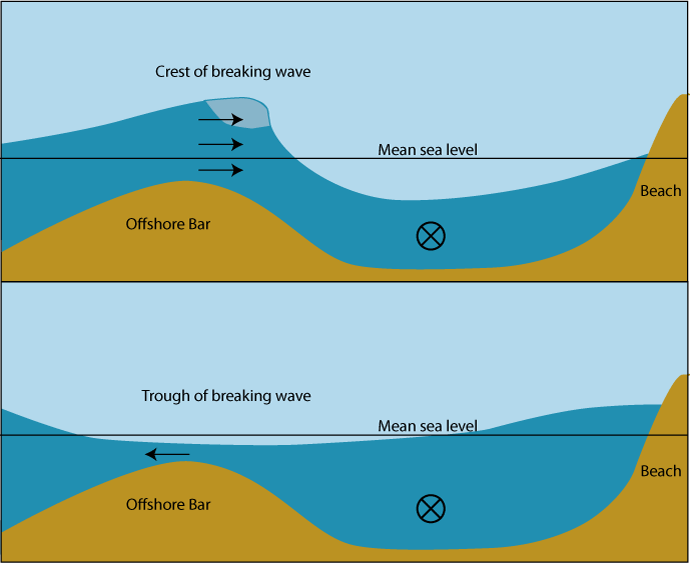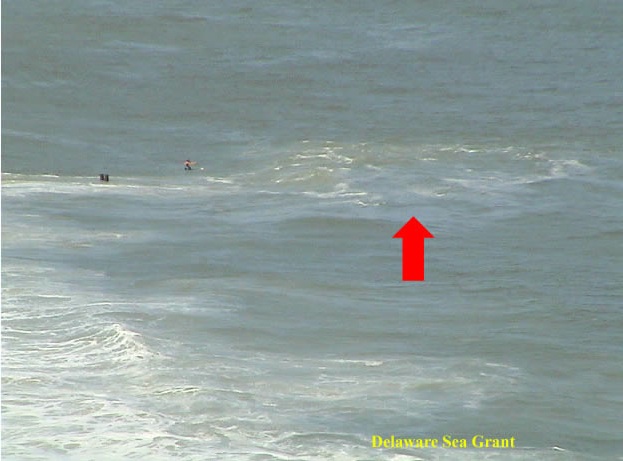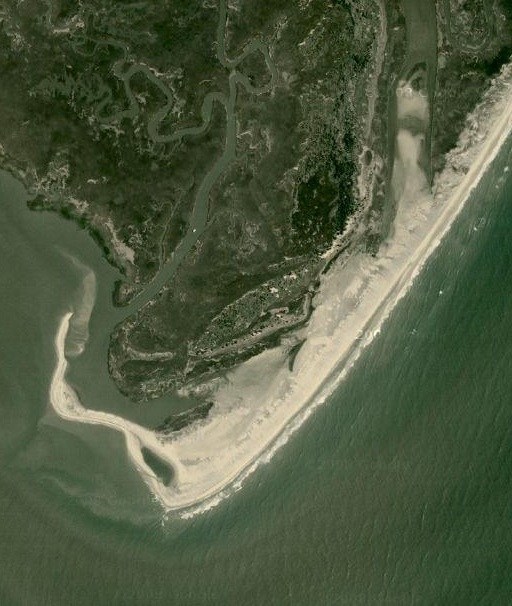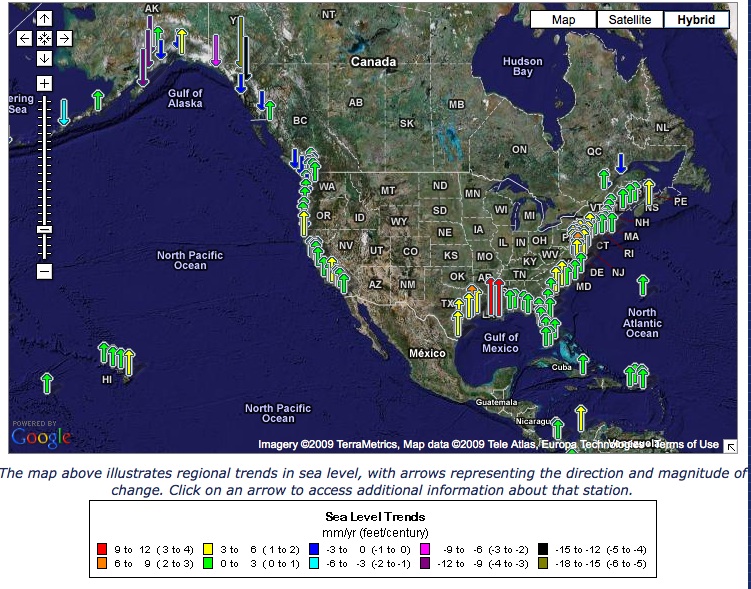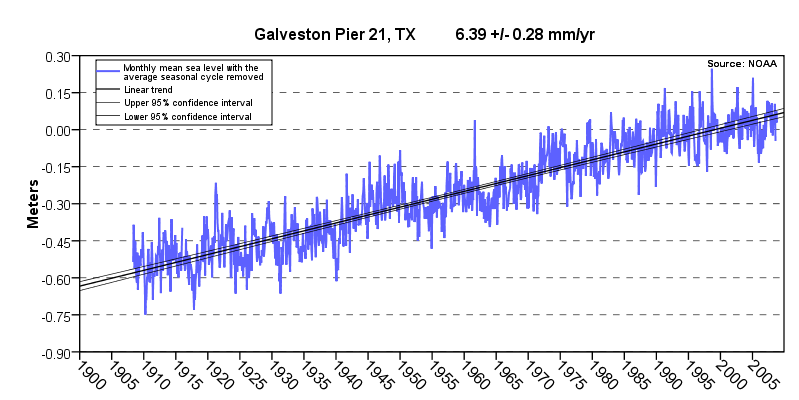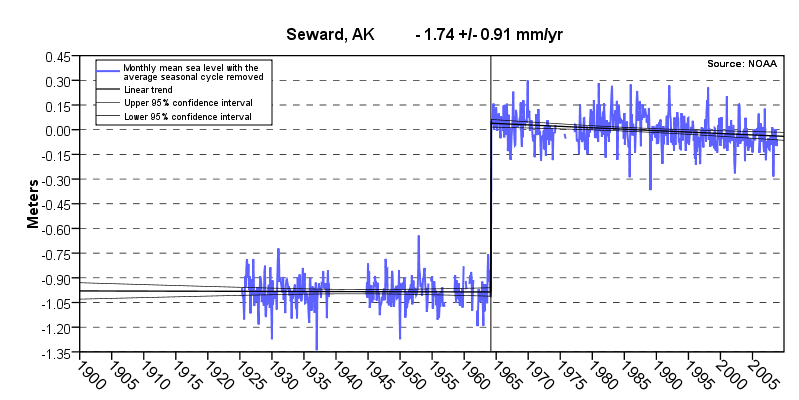
Beach Processes
Beaches constantly change. They may be high and wide during the summer, then
disappear during winter storms. Barrier islands "move like curtains in a
breeze," shifting location from year to year and decade to decade. Inlets
come and go. What processes lead to these changes?
Waves
Beaches need waves. No waves, no beaches. This is why lakes rarely have beaches. Waves breaking offshore of the beach lose energy and create turbulence which suspends sediments (mostly sand, but sometimes pebbles or even boulders). Small waves carry sand up higher on the beach, building high wide summer beaches. Storm waves erode the beach and carry sand offshore. Erosion by storm waves is episodic. It occurs mostly in rare but severe storms, hurricanes in the south and east coasts, nor' easters in New England, and during El Niño years in California. More information is in the chapter on Coastal Erosion.
Long-shore Currents
Breaking waves pour water into the surf zone. The water then moves parallel to the shore as an longshore current, carrying sand and other sediments along the coast, changing the shape of the coast, and forming and eroding barrier islands and spits.
Waves coming ashore first break on offshore bars. As the wave breaks, it pours water into the surf zone between the bar and the beach.
Top: Currents, shown by arrows, carry water into the surf zone as the wave breaks.
Bottom: After the wave breaks, very little water returns back to sea over the bar. Instead, it feeds an longshore current into the paper (shown by the circle with crossed lines).
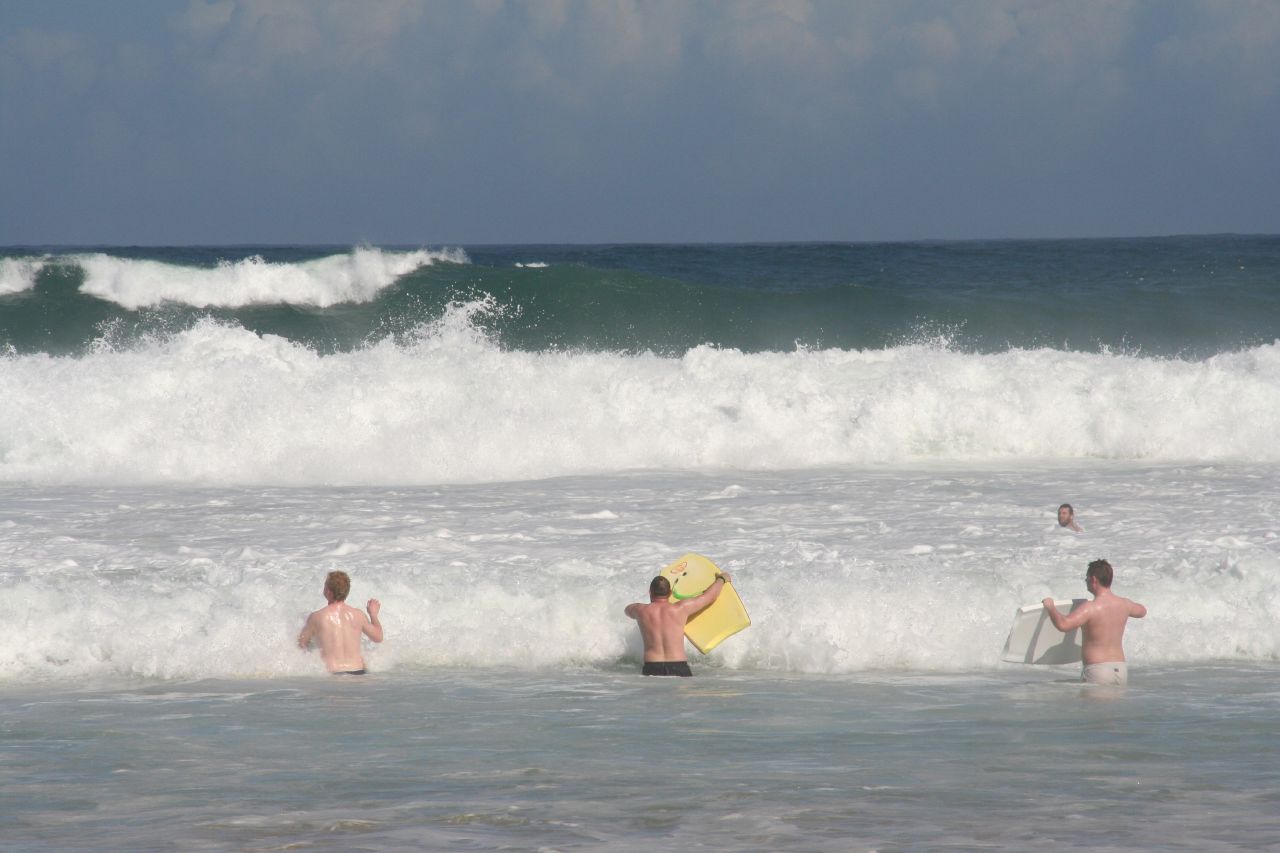
Three waves coming ashore at Bondi Beach, Sidney, Australia on 28 March 2006, are bringing water into the surf zone as walls of white water. The wave in the background is just starting to break on an offshore bar. The two waves in the foreground have broken and are coming towards the bathers as walls of white water. Click on the image for a zoom.
From Rob & Jules photographs on Flickr.
When the longshore current becomes sufficiently strong, it turns offshore in a fast, narrow current called a rip current. Rips are strongest and most dangerous on days with high surf. Rip currents are dangerous. Swimmers caught in a rip sometimes panic as they are carried offshore. Trying desperately to swim back to shallower water, they can tire and drown. The safest action is to swim parallel to the beach until out of the rip, then swim in.
Rip current at a beach (marked by the red arrow). This fast current is only a few meters wide, extending maybe 100 meters offshore.
See video on rip currents From NOAA .
Sediments carried along the coast by longshore currents change the shape
of the coast. Where storm waves erode the beach, the sediments are carried
away, to be deposited elsewhere, building new land.
Sand carried by longshore currents has built up the sandy beach at the bottom of this image of the coast Revel Island, Virginia. The current carrying sediments tends to flow from the top to the bottom of the image. Notice the clear water between the white water caused by breaking waves, and the beach. This indicates the waves are breaking on an offshore bar. Click on the image for a zoom of the breaking waves.
From Google Maps.
Tides
Tides raise and lower sea level from hour to hour and modulate the influence of waves and currents.
Wind
Beaches are composed mostly of sand. Wind carries the sand inland, creating dunes. Four conditions are needed for wind to create dunes:
- The sand must be dry. Wet sand near the waterline is held tightly by capillary forces. When the sand dries, wind can move the sand grains. Very flat beaches, and beaches of very fine sand or mud tend not to dry out. Mud and fine sediments running of land close to the beach keeps the beach moist, which eventually leads to loss of dunes. Bacteria fed by nutrient rich pollutants also inhibit drying.
- There must be tides. Dry beaches require tides that expose sand to drying by the sun during low tide, and the absence of groundwater that keeps the beach wet. Seas with weak tides tend to have small beaches.
- There must be an onshore wind. The wind must be strong at the sand, and blowing sand higher onto the beach. Beaches with cliffs and buildings that block the onshore wind will not have dunes. Strong wind blowing over a dry beach blows sand in windrows, the lighter areas in the photograph below.
- There must be low obstacles that slow the wind, causing sand to be deposited on the surface near the obstacle. Grass and other vegetation in dunes slow the wind, causing growth of the dunes.
Thus wind, tides, dry beaches, and beach grass are essential for formation of dunes.
Sand blowing along a beach on Cumberland Island, Georgia. Click on the image for a zoom.
From Anorlunda.
Changing Sea Level
Rising sea level due to climate change, and changes in the height of the land due to geological processes, cause sea level to slowly rise or fall. Throughout most of the USA, sea level is rising, slowly inundating the coast, causing the sea to move landward and the land to move seaward. Along some coasts, especially in Alaska, sea level is dropping.
Map of changes in sea level around the United States. Click on the image for a zoom.
From NOAA Sea Levels Online.
A century of sea-level change at Galveston Island measured by a tide gauge on Pier 21. Click on the image for a zoom.
From NOAA Sea Levels Online.
80 years of sea level change at Seward Alaska measured by a tide gauge. The vertical line marks the time of the very large Valdez earthquake which shifted sea level at Seward. Click on the image for a zoom.
From NOAA Sea Levels Online.
Sand Supply
Sand on beaches comes from the erosion of rocks on land. Rivers carry the sediments to the coast. The construction of dams has slowed the flow of sand to coastal regions.
Humans have simultaneously increased the sediment transport by global rivers through soil erosion (by 2.3 ± 0.6 billion metric tons per year), yet reduced the flux of sediment reaching the world's coasts (by 1.4 ± 0.3 billion metric tons per year) because of retention within reservoirs. Over 100 billion metric tons of sediment and 1 to 3 billion metric tons of carbon are now sequestered in reservoirs constructed largely within the past 50 years.
From Syvitski et al (2005).
More Information
To gain a deep understanding of beach processes, I recommend you read Dunes and Beaches by J. Floor Anthoni, who has spent a lifetime studying beaches. This is one section of his online Oceanography Book published by Seafriends Marine Conservation and Education Centre. His pages are full of wisdom learned from first-hand experience.
Reference
Syvitski, J. P. M., C. J. Vorosmarty, et al. (2005). "Impact of Humans on the Flux of Terrestrial Sediment to the Global Coastal Ocean." Science 308 (5720): 376-380.
Revised on: 27 May, 2017

